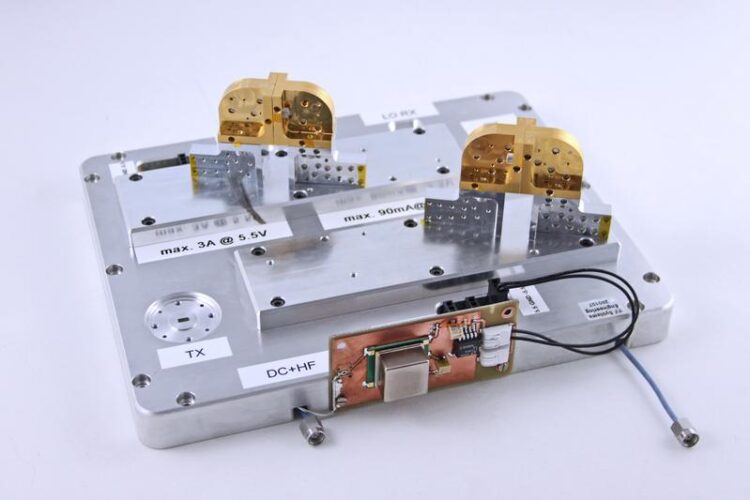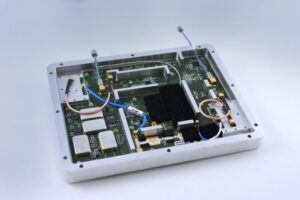Novel developments for 6G communication systems and green ICT

140 GHz D-band wireless communications system module with antenna interface
FBH/Nicole Vlach
The Ferdinand-Braun-Institut (FBH) will present its research results targeting energy-efficient amplifier concepts as well as terahertz (THz) components and systems for broadband communication and imaging at the virtual “European Microwave Week” (EuMW). In addition to its conference contributions, FBH exhibits from January 12-14, 2021 at the joint booth of the “Research Fab Microelectronics Germany” (FMD) in ex-hibition hall 3 – with FBH scientists available for a virtual exchange.
The relevance of the internet is even growing in times of pandemics and the digital era. Powerful new communication standards like 5G and 6G form one of the pillars in this development. Pushing carrier frequencies into the sub-terahertz range above 100 GHz is a key enabling technology for high-speed transmission in the future.

FBH/Nicole Vlach
At the EuMW, the FBH is presenting results of the ULTRAWAVE project. Within the consortium, a novel wireless communication system architecture with improved area coverage and unprecedented data rates is developed. FBH contributes MMICs with its InP DHBT process. The architecture provides 100 Gbps/sqkm by introducing a point-to-multipoint infrastructure at 140 GHz in the D-band.
The system is currently being set up at a test site in Spain. Once successfully demonstrated, this will be the first demonstration of a point-to-multipoint wireless communication system with such high data rates – point-to-point systems in the same frequency band have already been demonstrated in first experiments by other groups. The system will use standard modem access and wireless data transmission with distances up to 1 km.
FBH developments for green ICT
Reducing energy consumption is one of the keys to limiting global warming. The FBH presents two different approaches to improve energy efficiency in information and communication technologies (ICT) at the accompanying trade show.
Envelope tracking is a well-proven technique for increasing the efficiency of solid-state power amplifiers. This is achieved by modulating the supply voltage of the RF power amplifier in accordance to the instantaneous signal envelope. The FBH has developed a 1.62 GHz amplifier with a peak output power of more than 50 W and a modulation bandwidth of 40 MHz. With an 8.6 PAPR (peak-to-average power ratio) signal, the overall efficiency reaches 40 %.
FBH has also transferred the concept of supply modulation to millimeter wave amplifiers. A module with two identical MMICs with integrated switches for discrete level supply modulation has been developed. It operates in the 24-26 GHz range with 14 dB gain. Calculations for a single-chip realization show that 5-15 %-points efficiency improvement can be expected depending on the statistics of the signal.
Another approach to reducing power consumption is being pursued by the concept of a digital power amplifier. Based on FBH’s 0.25 μm GaN-HEMT process, the institute has realized the first fully digital transmitter chain that successfully transmits broadband signals with maximum efficiency and linearity (47 % at > 52 dB ACLR). The compact digital transmitter brings the boundary between the digital and analog part of a base station up to directly before the antenna.
Further exhibits at the virtual trade show
In the field of terahertz electronics, FBH will also present THz detectors based on GaN HEMT MMICs that can be arranged into 2D arrays. They are suitable, for instance, for non-destructive testing of plastics for material defects. With best values for noise equivalent power NEP below 25p W/sqrt (Hz) and a highest sensitivity of 100 mA/W at 500 GHz they outperform previous THz detectors in CMOS technology.
Furthermore, the FBH exhibits its integrated GaN-based laser drivers for LiDAR applications, used e.g. for autonomous driving. The design of the output circuit is optimized for high peak current, short optical pulse width, high repetition rate, and power efficiency. It allows unprecedented performance in terms of current and pulse width, from 800 A at 4 ns to more than 30 A at 0.5 ns.
Weitere Informationen:
Media Contact
All latest news from the category: Trade Fair News
Newest articles

High-energy-density aqueous battery based on halogen multi-electron transfer
Traditional non-aqueous lithium-ion batteries have a high energy density, but their safety is compromised due to the flammable organic electrolytes they utilize. Aqueous batteries use water as the solvent for…

First-ever combined heart pump and pig kidney transplant
…gives new hope to patient with terminal illness. Surgeons at NYU Langone Health performed the first-ever combined mechanical heart pump and gene-edited pig kidney transplant surgery in a 54-year-old woman…

Biophysics: Testing how well biomarkers work
LMU researchers have developed a method to determine how reliably target proteins can be labeled using super-resolution fluorescence microscopy. Modern microscopy techniques make it possible to examine the inner workings…





















